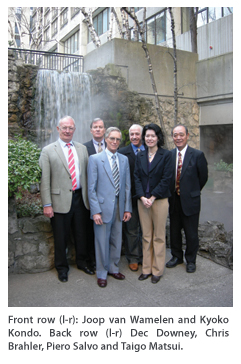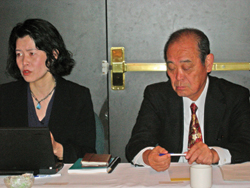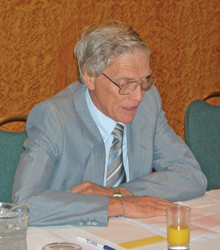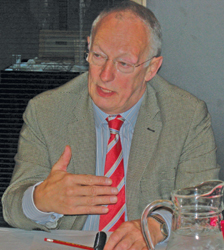2009 Editorial Roundtable

Each year at the No-Dig Show, Trenchless Technology assembles leaders
of the trenchless community to discuss various issues affecting the
trenchless industry. As this year’s No-Dig Show was an international
event, we decided gather perspective about the trenchless market inside
and outside North America’s borders.
 We were pleased to have trenchless leaders from ISTT and its Affiliated
We were pleased to have trenchless leaders from ISTT and its Affiliated
Societies share their thoughts on the global trenchless market, the
downturn in the world market and its impact on the trenchless work in
their countries. The roundtable discussion was held Tuesday, March 30
at the Sheraton Centre in Toronto, Ontario, Canada. The moderator was
Trenchless Technology editor James W. Rush. The participants were:
- Piero Salvo, NASTT (Canada),
- Joop van Wamelen, SASTT
- Chris Brahler, NASTT (United States)
- Taigo Matsui/Kyoko Kondo, JSTT
- Dec Downey, ISTT
How do you see the global economic downturn affecting trenchless technology? What impact is it having on your area?
Joop van Wamelen: The areas where the growth in
trenchless technology would be most affected would be the developed
part of the world. In southern Africa, which is basically the area
south of the Zambezi River, the whole construction sector is still in a
growth phase because of the backlog work that needs to be done. Another
factor that is affecting South Africa is that the relatively new
democratic government has instituted what it calls the Municipal
Finance Management Act. This puts an obligation on municipalities to
practice asset management and municipalities are being dragged into
this kicking and screaming. But it is an act of parliament and if you
don’t comply then the municipal manager could go to jail. So, the
municipalities are now starting to implement asset management and in
the process they are finding that their underground assets are in a bad
state and more and more they are turning to trenchless rehabilitation.
So trenchless technology in South Africa is in a growth phase.

North America, I am very optimistic for the growth of trenchless
technology. One indication is the success of the International No-Dig
Show here in Toronto. It’s typical of the enthusiasm we hear in the
United States. The United States right now is going through some
interesting times but trenchless is one the area that is surviving all
this economic turmoil. A lot of contractors have backlogs through the
fall and they are cautiously optimistic that they their businesses will
be fine. We are also seeing improved methods and higher quality if
work, which is key to continued growth.
Piero Salvo: In Canada, we do not see a
slowdown either. The biggest problem that we have right now is we don’t
have enough contractors. There are so many projects coming out. And
it’s for many reasons. Trenchless is the way to go because it takes
less time and it’s a lot greener. That’s been a buzzword lately, but in
trenchless it’s really true. There’s a lot less disposal of materials
and less material that you need to bring in, so all this comes into
play when you are analyzing projects. In general, the trenchless
projects cost less. So, you’re really getting a lot more bang for your
buck. And I do not see it slowing down anytime soon.
Dec Downey: In Europe, we have a variable picture.
There are huge differences between Eastern Europe and Western Europe.
There’s much growth in Eastern Europe with new construction work going
on. In Western Europe and Southern Europe we’ve got a lot more
rehabilitation going on in different countries being driven by
different mechanisms. Germany is very quality driven. The United
Kingdom is a very privatized water industry and gas industry, so we’re
driven there by the cycles of business. We had been going through a
period driven by water quality in which we were doing 2,000 to 3,000 km
of spray lining a year, but that is coming to an end. We’re going to
see a lot of structural work. Delegates to this conference are
confident that spending levels will be maintained, so I think were
going to see quite steady growth. Although there are concerns about the
economy at this moment, it’s mainly because we’re on the shoulder of
one spending plan and moving into the next one.
Taigo Matsui/Kyoko Kondo: In Japan,
trenchless is widely accepted and more people are using it. There are
some new technologies that are coming out that made the scope of the
applicable range wider than it used to be. More techniques can be
applied to many soil types. The new technique we think will be used
more. But the world recession is hitting us very hard. Trenchless
projects are decreasing at the moment, despite of the newly developed
techniques. In fact, pipe jacking construction for sewers has dropped
from 1,200 km in 1999 to 750 km in 2007.
One example of a new technique is a form of pipe jacking called pipe
eating in which the existing pipe is crushed and the pieces are
basically swallowed and discharged to the surface, so you don’t leave
any piece of the existing pipe in the ground. Municipalities would like
that nothing is left in the ground. This method is a little more
expensive, so growth is a little slow. But we are optimistic that it
will continue to get recognized and gain in popularity.
Briefly describe the state of the trenchless market in your area.
van Wamelen: In South Africa, the cost of installation
and repair has very little to do with what methods are used. What we
find more often is the backlash of the population of the deterioration
of the infrastructure. For instance, last summer for a couple of
months, we had electricity blackouts. Of course, the electricity
utility had not been making the capital investments needed to maintain
its infrastructure and it began to fail. When the blackouts finally
began stopping, there was backlash and a lot of criticism from the
public. As a result the major water suppliers in the country took the
lesson to heart and are working very hard on asset management, finding
out what is wrong commissioning rehabilitation work.

In the United States, there is a lot of work resulting from federal
mandates. For example, the City of Atlanta has been ordered to spend in
excess of $3 billion to upgrade its sewer and water system. Similar to
the case of the electric utility in South Africa, the city had not made
the necessary investments until they were forced to. But as a result,
there is a huge need for work and a lot of it will be done
trenchlessly, including pipe relining and pipe bursting. Other
trenchless methods for inspecting and monitoring pipes are being used
for improved management and planning. Overall, these techniques will
save cities a lot of money.
We are also seeing the use of trenchless in smaller communities. In
some cases, smaller cities are more progressive than the larger cites.
We’ve seen a lot of small communities do pipe bursting long before a
big city will do it because there’s not as much loyalty to the pipe
that they’ve been using for 50 years, so they’ll try a different type
or more modern pipe. The rural areas actually have some of the best
projects. Not as big, of course, but still very progressive.
Salvo: Recently, the government has come up with an
infrastructure program with hundreds of millions of dollars to
stimulate the economy. They’re trying to get projects out as quickly as
possible. Which projects are quicker to develop and be able to be
done? It’s the trenchless projects. In addition, there are policies in
Quebec where they actually force the municipality to spend a percentage
of their replacement of water main using trenchless. So as far as the
economy, yes people are cautious, but it seems to be going forward
quicker than we can react at this point.
Downey: In the United Kingdom, local revenues of the
water companies are down because they’re large sellers to industrial
and energy customers, who are buying less water. For example, the car
industry has almost closed down completely. It’s probably not having
any effect on the trenchless proportions because the industry is
extremely willing to use trenchless technology, but usage levels are
running at 60 or 70 percent so there is less money for projects overall.
Matsui/Kondo: Since 1997 as a means of financial
reform, the government began reducing spending on public works
projects. In 2008 spending for sewers was down 50 percent. However, one
positive sign is the government’s willingness to spend on safety
measures, including burying electric cables and building improved
communications networks. The government is also taking other measures
to boost the economy that could have a positive impact on trenchless.
What methods of construction and rehab are common to your area? Are
there any innovation products, processes or practices that have come
from your area?
van Wamelen: In South Africa, pipe bursting and lining
for sewers are the most common forms of trenchless technology. At this
time all lining materials are imported and as a result are expensive.
It would help if we were able to develop resins and felt locally to
drive make them more affordable. Pipe jacking is still very common for
new installation of sewers and directional drilling is having a boom
time as the result of a large-scale installation of fiber-optic cables
for broadband. Some new techniques are sometimes viewed as risk. SASTT
is working on standards that would go a long way to ease entry into the
market.

are seeing many innovative methods, which in many cases are coming from
the contractors in the field. In some cases you see a merging of
technologies, like HDD being used with pipe ramming. Pilot tube work is
an area that’s been growing dramatically in North America — and
sometimes you will see them used in conjunction with pipe rammers on
difficult projects too.
Salvo: In Canada, we are seeing a lot of CIPP lining
of water mains. Here at the International No-Dig there are a lot of
companies with new lining products available, and I see that as an
emerging area. There is also a lot of sliplining, tunneling and
jacking. One thing that I’ve noticed too is that there are a lot more
diagnostics. Municipalities know what they have, but there seems to be
this additional drive to be able to really assess what they have, so
that they come up with a better plan. There’s a lot of planning going
on as well as execution.
Downey: Historically there has been a lot of
innovation coming from the United Kingdom. CIPP and spray lining
started out there. And in the last few years, we’ve seen a lot more
innovation. Even in very basic activities, like pipe cleaning, there is
a new technology using an ice pig for cleaning that is a really
innovative technique. I think we will see more innovation as there is
going to be an upswing in sewer rehabilitation as there is more
emphasis on that going forward. I see more of a need for structural
repair of water pipes going forward too because of the past emphasis on
addressing red water problems. Traditionally U.K. water companies have
been willing to embrace new technologies. In fact, companies like
Wessex Water embrace innovative technologies because of the
cost-savings.
Matsui/Kondo: Japan is still the country of pipe
jacking, even though we are doing less now than 10 years ago.
Trenchless technologies are well accepted in Japan because of the small
spaces available for construction in the cities. Most of the newly
developed techniques can be used in any areas and in all soil types.
It seems that many times different regions go through their own
learning process with certain techniques. What can be done to help
facilitate information exchange so that we don’t have to keep
re-learning the same lessons?

venue is right here at the No-Dig Show. The fact that it’s the
International No-Dig Show encourages information exchange across
borders. Improved communications are also facilitating information
exchange. There are newsletters, blogs and Web sites that have a wealth
of information, in addition to industry magazines. The information is
out there. In North America, there is a good exchange of information
between Canada and the United States as technologies going both ways.
As an example, CIPP lining of water mains is beginning to take a
foothold in the United States. It’s slowly starting, but you do see it
more and more.
Brahler: The ISTT has set up a committee to answer
technology questions from municipalities or utilities. That’s a great
tool to transport information globally.
Downey: Yes, the technical panel from ISTT is
beginning to be very effective. We also have the ISTT master class
program which offers a comprehensive look at trenchless techniques. The
plan is to offer those four or five each year.
Additionally, the U.K society and the Japanese society have a very
interesting exercise where the Japanese were kind enough to host our
young engineer of the year. He had two weeks learning about all kinds
of technologies. I’d like to see people from Japan coming to the U.K.
on that basis. We’ve also seen activity from the Italian society.
That’s a huge program with an outreach into the North African
countries. They received a large amount of money from the government to
go do that, which is really encouraging. So there are all kinds of
activities going on the formal and informal level, which will help to
break down the barriers and promote technology exchange between
countries.
How has the global marketplace changed in recent years?
Salvo: There is more of an acceptance of trenchless
techniques. The technology is improving and the contractors are
improving, so it makes it easier for the municipalities to use. They
are not as afraid to do it because now there is a track record. Now
they’re not the guinea pig.
Downey: If you look at what’s happening in India
currently, trenchless technology has really shot off to a massive
start; $100 million is being spent in every major city in India. That’s
a country where they can afford to pay people to do work in trenches.
They’re choosing deliberately and the funding agencies are insisting on
using trenchless technology because they’re going to get the job done
once and get it done properly.
van Wamelen: We are also seeing cases where trenchless
is being done for social considerations. If the costs are close, they
are going to use trenchless because they don’t want the backlash from
the public.
Downey: That’s a very strong point. If you look at
what’s happening in India currently, trenchless technology has really
shot off to a massive start; $100 million is being spent in every major
city in India. That’s a country where they can afford to pay people to
do work in trenches. They’re choosing deliberately and the funding
agencies are insisting on using trenchless technology because they’re
going to get the job done once and get it done properly.
Brahler: With all the progress we’ve made and all the
people we’ve educated, there are just as many people who don’t
understand it. Our job is still, in my mind, in the beginning. One
problem we are facing is that we have all these great technologies, but
with open, low-bid procurement, sometimes we have a hard time getting
contractors that operate at a high-quality level.
What are the emerging areas or markets for trenchless technologies?
Downey: We tend to think of trenchless being water and
sewer, but in our conference in Rome in 2007, we learned that 70
percent of the trenchless work in Italy is sponsored by Italian
Telecom. It’s a huge business.

lateral market is a market that people don’t really think about, but
it’s huge and it’s growing. When you consider that along with the
electric, telecom and oil and gas markets also doing well, the
trenchless industry is firing on all cylinders. That does create
quality issues of getting qualified contractors to do the work. That’s
a real challenge for our industry because poor quality can destroy a
method faster than anything else.
Downey: The education and training of installers is an
area that’s going to impact the growth of trenchless and the growth of
our business. I think we are going to see a push for certified
installers. It happens in some niches of our business, and it’s going
to happen in a lot more of them. We’re beginning to see customers
insisting that only qualified operators are used.
At the end of the day, whoever is paying for the work has the most
interest in the job’s accomplishment. Whether it’s a government or
privatize institution, they’ve actually got to be insisting that the
contractor’s specifications will work properly in the training. They
have to work with the educators and our organizations to set up
training schemes to enable people to be trained and to be measured and
be continuously monitored. When we have that – and we do see that
happening in some areas —we’re going to see quality standards taken to
the next level.
Brahler: That also includes the training of
inspectors. Knowledgeable inspectors are needed to watch the
installation procedure and recognize any improper installation
practices.

Comments are closed here.